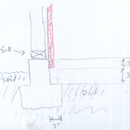Pouring concrete walkway / drainage up to old T style foundation in clay soils
For pouring a new walkway/drainage channel next to an old T style foundation, I’m torn between two goals: keeping termites from having path into this wall, and protecting the foundation from undue pressure or torque.
I’ve received advice to rod the old foundation and bond a new concrete walkway to the foundation.
And other advice, to pour much thinner, leaving space for a foamed expansion joint material to buffer the old foundation from the new drainage channel. What would you do?
——–
This is a 1938 stucco building in the Mediterranean climate San Francisco Bay Area (no freezing, 9 months dry). The original stucco was troweled to ground level. The original “paper” was mostly eaten by the termites or otherwise disappeared. The original concrete walkway here was poured about 3″ above the stucco edge, making a near perfect termite entry path.
The long term future of the house is probably taking thousands of pounds of stucco to the landfill, and restuccoing the entire thing.
And a wider view:
https://www.flickr.com/photos/10105026@N07/albums/72157660066504328
GBA Detail Library
A collection of one thousand construction details organized by climate and house part










Replies
Bryce,
Although you didn't tell us which side of the sketch is the interior and which is the exterior, I'm going to guess that the interior is on the left, and the exterior is on the right. I'm going to guess that the red material is stucco, and that the horizontal layers on the right are crushed stone and concrete for the new walkway. Did I guess correctly?
I have never worked in a termite-infested area, but I don't see any advantage to connecting the new concrete walkway with the foundation, and I see several possible disadvantages. I vote for no rebar connection.